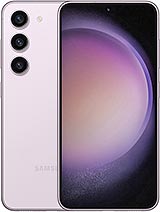Google Pixel 8 review
6.2-inch OLED with 120Hz refresh rate
This year's small Pixel gets a significant upgrade in the display department. It's now smaller in size, measuring 6.2" in diagonal, as opposed to the 6.3-inch screen from last year, but features a higher refresh rate and higher brightness. Even though it's not LTPO OLED like on the Pixel 8 Pro, the vanilla 8's screen is still 120Hz; it supports HDR10+ content and can boost its brightness up to 2,000 nits when playing HDR videos.
This is a big step up for the Pixel family, as the last two generations were dragging behind the competition in this regard. And the upgrade is noticeable, going by our standard display tests. In fact, we were surprised to see the Pixel 8's panel boosting up to 1,001 nits in manual mode. When the control is set to automatic, the screen can go up to 1,446 nits - another excellent result - and it's as much as Google is advertising for the Pixel 8's high-brightness mode.
Color accuracy is another great advantage of the Pixel 8's panel. Even in the default color mode, colors are highly accurate, but going for the Natural color preset would bear even better results with an average dE2000 of just 1.1. That's exceptional color accuracy.
HRR control
The Pixel 8 doesn't get a granular refresh rate control as the panel isn't LTPO, but it does offer some sort of refresh rate control to preserve battery life. The control is pretty simple, though - the screen will always prioritize a 120Hz refresh rate unless you stop interacting with it. When the screen is idle, it will dial down to 60Hz. This remains true for all system menus and apps we've tried. Even YouTube's UI runs at 120Hz, but if you aren't touching the screen during video playback, it will resort to 60Hz. Chrome seems to behave as expected, and if moving objects are on the screen, it won't reduce the refresh rate below 120Hz.
Battery life
This year's vanilla Pixel gets a bigger 4,575 mAh battery and supposedly more efficient 4nm-based chipset.
In our Active use test, the Pixel 8 posted roughly the same numbers as one of its most obvious rivals, the Galaxy S23. The small Pixel's overall score is also more or less the same as that on the Pixel 8 Pro, albeit the vanilla model is notably better at web browsing. That said, both a Zenfone 10 and an iPhone 15 Pro will get you significantly better longevity than the Pixel 8.
Expand to reveal our legacy battery test (Endurance rating). How we test now.
The results we got in our tests are far from ideal. We see a slight uptick in the browsing test and no significant change in the video playback scenario, but there's a notable drop in the screen-off tests.
Our battery tests were automated thanks to SmartViser, using its viSerDevice app. The endurance rating denotes how long the battery charge will last you if you use the device for an hour of telephony, web browsing, and video playback daily. More details can be found here.
This results in a sensible decrease in the overall endurance score from 96 hours last year to 83 hours on today's Pixel 8. However, for power users constantly on their phones, the Pixel 8 may actually prove to be a decent performer. The screen-on tests are arguably more important, so even though we didn't see an improvement in those, they are still pretty impressive for a small flagship phone. We are puzzled by the screen-off tests, which should have been better given the bigger battery capacity.
Video test carried out in 60Hz refresh rate mode. Web browsing test done at the display's highest refresh rate whenever possible. Refer to the respective reviews for specifics. To adjust the endurance rating formula to match your own usage patterns check out our all-time battery test results chart where you can also find all phones we've tested.
Charging speed
The charging speed is another upgraded component of this year's Pixel phones. The smaller Pixel can now support 27W fast charging, which isn't impressive by today's standards in general, but it's a significant step forward in Pixel terms. The handset gets 56% of its charge back in the first 30 minutes and charges fully within 1 hour and 16 minutes. That's about 24 minutes faster than last year.
Interestingly enough, when compared to some of its competitors, the device seems to struggle in the first 15 to 30 minutes of the charging cycle but pulls ahead in the last few percentages. It's not enough to overtake the Xiaomi 13, but it's enough to outperform the iPhone 15 by a landslide as well as match the Galaxy S23's charging capability.
Speakers
The stereo speakers setup is identical to last year's - a hybrid solution with a bottom-facing speaker paired with one acting as an earpiece as well. This usually means that the top one is slightly quieter, which is indeed the case here too.
The loudness score is almost identical to last year's Pixel 7, -26 LUFS, which, in turn, is the same as the Pixel 6 from 2021. Tuning also sounds familiar, with the Pixel 8 producing decent enough bass, for a phone of this size, clear vocals and minimal distortion at high volumes.
The device also offers an adaptive sound feature, which uses the Pixel 8's microphones to assess the acoustics and ambient noise and adjust the tuning of the speakers on the fly.
Use the Playback controls to listen to the phone sample recordings (best use headphones). We measure the average loudness of the speakers in LUFS. A lower absolute value means a louder sound. A look at the frequency response chart will tell you how far off the ideal "0db" flat line is the reproduction of the bass, treble, and mid frequencies. You can add more phones to compare how they differ. The scores and ratings are not comparable with our older loudspeaker test. Learn more about how we test here.
Reader comments
- Leo
- 06 Apr 2025
- qHc
Agreed, same with mine
- Jenny
- 16 Feb 2025
- 4QL
Love how it takes it upon itself to lower brightness and then act like it is at full brightness. It's a known glitch, battery saver, everything is off and yet it still controls my own phone itself. Also have issues googling things, won't le...
- John Conner
- 16 Jan 2025
- svN
Thats not the phone but your network provider



